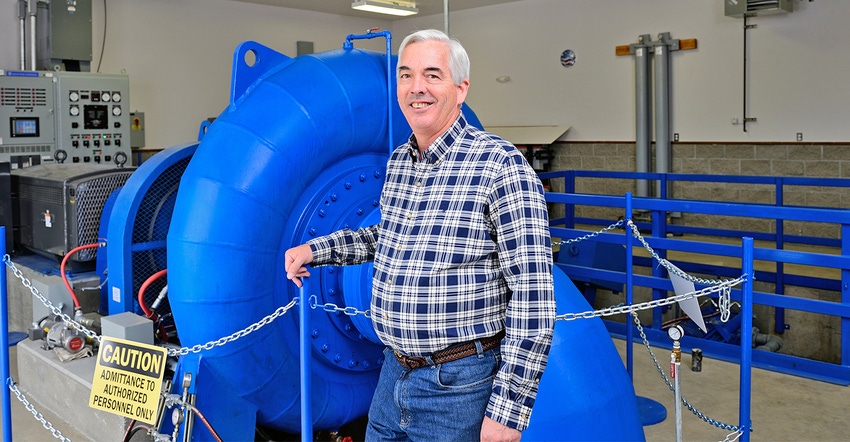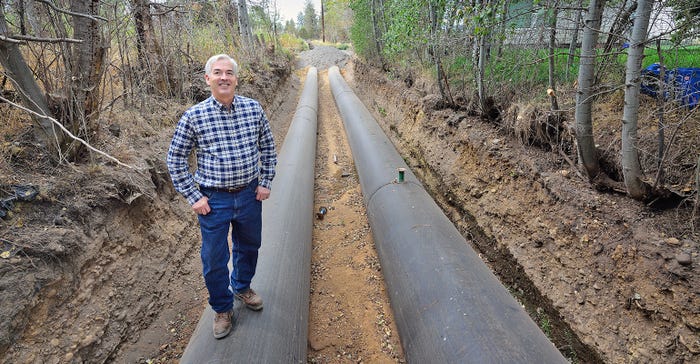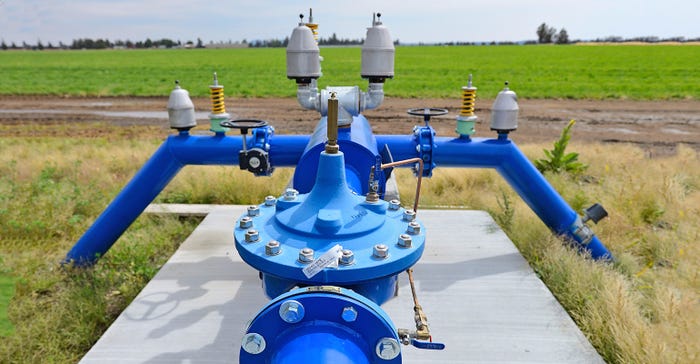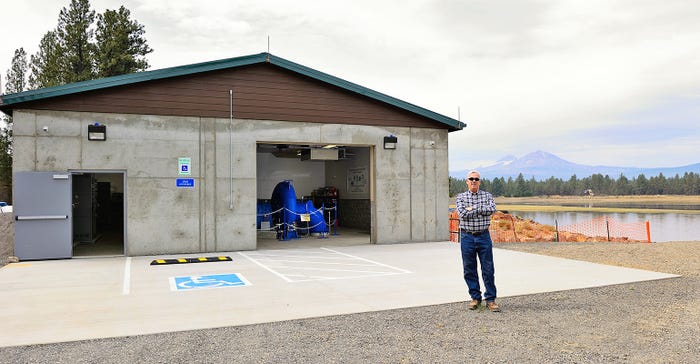February 27, 2018

Editor’s note: This is the fourth story in a series exploring how ranchers and farmers are benefiting from renewable energy.
Oregon farmers are saving thousands of dollars in electrical bills, growing higher-value crops, weathering droughts much better and improving habitat for fish and wildlife.
This quadruple win is thanks to irrigation modernization and the related installation of three hydropower stations that will provide enough electricity to power about 430 homes in the region.
“The project within the Three Sisters Irrigation District is really a model for what we’re trying to do with our irrigation modernization program,” says Jed Jorgensen, senior renewable energy program manager for Energy Trust of Oregon. “It’s improving irrigation efficiency and creating opportunities to generate hydropower at the district and farm levels.”

Three Sisters Irrigation District Manager Marc Thalacker stands on new pressurized pipes installed in a former irrigation canal. The district has piped 55 of its 63 miles of canals, pressurizing its water supply, eliminating seepage and evaporation in the piped sections, and returning a portion of the conserved water to its source to support fish and wildlife habitat. The water savings also makes the district more resilient against drought, as no water is lost in the pipes on its way to delivery.

Energy Trust is a nonprofit organization dedicated to helping 1.6 million utility customers in Oregon and southwest Washington, including ranchers and farmers, save energy and generate renewable power. It provides cash incentives to develop projects, and it helps in a variety of other ways, including permitting.
“Many of the projects we’ve funded are helping ranchers and farmers improve their agricultural operations, and we see efforts to modernize irrigation and develop renewable energy spreading across the West,” Jorgensen says. “Projects like the one involving Three Sisters Irrigation District are becoming a model for what irrigated agriculture will look like in the future.”
Rethinking water and power
The district serves about 200 ag operations in central Oregon, and for years its member farmers were trying to figure out ways to diversify their operations, boost income and improve water efficiency. A variety of factors were leading the charge, ranging from high energy bills stemming from irrigation pumping costs to pocket-draining droughts, like one that left farms with only 10% of their expected water that year.
The irrigation district teamed with Energy Trust and others to begin replacing antiquated open irrigation canals with a pressurized pipeline system and hydropower stations.
“The new system is providing pressurized water to 100-plus farms encompassing more than 7,500 acres, and this is already saving the producers about $400,000 each year in electrical costs by reducing or eliminating pumping costs,” Jorgensen says.
Fifty-five miles of pressurized pipeline have been installed so far, with only 8 miles remaining.

After piping up canals, pressurized water is delivered to this Oregon farm served by the Three Sisters Irrigation District. A pressure reduction valve reduces the high pressure at this site down to the pressure appropriate for the farm’s irrigation system. In the future, farmers could also install hydroelectric turbines at sites like this, to operate in conjunction with the PRV and to generate energy for use on the farm.

Additionally, the first of three hydropower stations is complete. The 700-kilowatt station is providing enough electricity to power about 275 homes within the region’s electrical grid. Two additional stations being built will each produce 200 kilowatts.
“One of them will have four different hydroturbines, which will act as a test bed for helping to determine the kinds of turbines that would be appropriate for individual farm turnout locations,” Jorgensen says.
When the entire project is complete by 2020, Jorgensen says that about 60 of the district’s 200 ag operations can generate on-farm power with small hydro systems, and that’s why the smaller turbines are being tested in one of the Three Sisters Irrigation District stations.
The farmers who install hydro systems within their own operations will then directly offset energy costs.
“The systems that we can provide incentives for have to be tied to the electrical grid. They can’t be an off-grid system that, for example, would pump water into a remotely located stock tank,” Jorgensen says. “Under Oregon’s net-metering rules, folks are incentivized to generate all the way up to the amount of energy they use — but not more than that.”
Variety of funding sources, tax incentives for renewable energy
Farmers and ranchers across the country can apply for guaranteed loan financing and grant funding to install renewable energy systems through the federal Rural Energy for America Program, commonly known as REAP.
Another incentive that all ag producers can take advantage of is the renewable energy tax credit for solar projects, while several programs are offered at the state level.
In Oregon, for example, the Energy Trust of Oregon has helped irrigation districts and individual farmers and ranchers develop renewable energy. Among its many projects, the organization provided technical support and more than $1 million in incentives to help install the Three Sisters Irrigation District’s pressurized pipe system and hydro stations.
“We also helped the district work through challenges in permitting and interconnecting the hydro plants with the local utility,” says Jorgensen.

Marc Thalacker, Three Sisters Irrigation District manager, stands in front of the district’s 700-kilowatt hydroelectric power plant, which was constructed in 2014.

The organization receives millions of dollars each year from Portland General Electric and Pacific Power to help the ag industry, businesses and residents generate renewable energy; this year’s allocation will be about $14 million. In addition to hydropower, other projects include solar, geothermal, wind and biogas — the latter of which turns food, agricultural and municipal waste into energy.
“Oregon has more than 12,000 successful renewable energy systems online — mostly solar — but there is significant potential for growth,” Jorgensen says.
Growing higher-value crops by putting water under pressure
Switching from open irrigation canals to a pressurized water pipeline system is allowing central Oregon farmers within the Three Sisters Irrigation District to diversify their operations and grow higher-value crops.
“Getting their irrigation water under pressure has caused a lot of producers to think about what it is they are growing and how they are going to grow it,” says Jorgensen of Energy Trust of Oregon, which is helping farmers, ranchers, irrigation companies and others modernize their irrigation systems and install renewable energy projects.
“The Three Sisters Irrigation District has seen a lot of producers shifting to higher-value crops, and when they make that shift they’re also reinvesting in their farms by upgrading to pivots, buying new tractors and building new farm buildings,” he says. “That’s been totally driven by just getting the water under pressure, and not having to pay those high pumping bills.”
Among the crops grown within the district are grains; alfalfa and grass hay; carrots, sugarbeets, onion, dill and alfalfa for seed; and garbanzo beans, Austrian winter peas and mint. Producers also raise livestock, and more of them are growing industrial hemp for the expanding cannabis oil industry.
Jorgensen says that the pressurized water system allowed one farm to replace 27 acres of hay ground with organic vegetable production, boosting profits from that parcel alone from about $25,000 annually to $250,000.
Another farm shifted part of its alfalfa acreage to higher-value carrot seed.
“Yet another switched to growing industrial hemp and purchased an oil processing plant to extract cannabidiol hemp oil,” he says. “They also bought wind turbines to help keep frost off the plants.
“At the same time, Three Sisters Irrigation District is much more efficient in its delivery of water, which will be really important during drought years,” Jorgensen emphasizes,
Farmers only got 10% of their expected water during an extreme drought in the 1970s, and the creek that supplied water to the open canal system literally dried up. This not only hurt the agricultural producers, but also fish and wildlife habitat, which strained the ag community’s relationship with others.
“We had a very similar drought in 2015, and because of the pressurized water system, Three Sisters Irrigation District was able to deliver up to 40% of expected water to its growers, while also keeping 20 cubic feet per second of water in the stream,” he says. “Reduced operating costs for farmers, drought resilience, and water for fish and wildlife are all part of the win.”
Waggener writes from Laramie, Wyo.
About the Author(s)
You May Also Like




